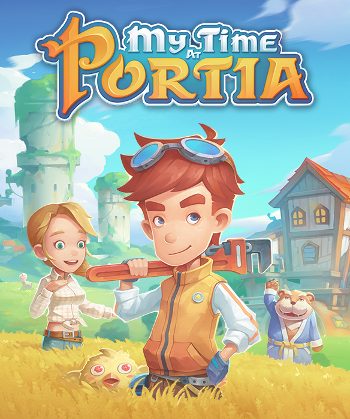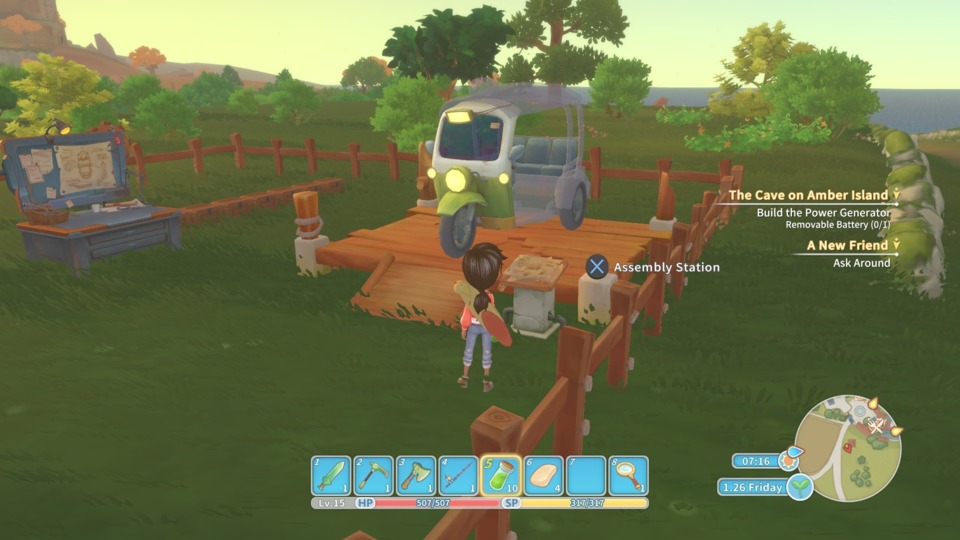Indie Game of the Week 250: My Time at Portia
By Mento 1 Comments

What better way to finish off a year of Indie game reviews, and especially this year in particular, than with something as relaxed and breezy as a slice-of-life-sim? My Time at Portia, originally released in 2019 by Chinese studio Pathea Games, takes the type of formula most recently championed by Stardew Valley (but has been around much longer) in that you operate your own business in a peaceful frontier town earning money and renown via any (legal) method you please. That might mean taking commissions and crafting your client's desired objects in your atelier, digging through the ruins of the old world for priceless relics and ores and other valuables, cultivating your own garden or livestock, bashing monsters for loot, or upgrading the tools you have to do all of the above more efficiently. You can also befriend (and date (and marry)) the townsfolk, donate to the local museum, take part in annual festival days for special rewards, or just sit on a park bench consuming libations until you pass out at 3am. Truly, the life you've always wanted is available in Portia.
The most striking quality of My Time at Portia, shared with a handful of other Indie Game of the Week candidates like Earthlock (IGotW #205) and Shiness: The Lightning Kingdom (IGotW #164), is that of its immense ambition. These types of multi-plate-spinning life-sims are difficult enough to program and balance at the best of times, or at least I'd imagine with their vast number of moving parts, so to do so in a fully open 3D environment as a fledgling Indie studio seems almost foolhardy. Evidence abounds of the unfortunate reality that the development team has maybe bitten off more than they can chew, with some bugs here and there, some activities feeling a little undercooked (like the combat), and the game's aesthetic having a lot of plain-looking environments and character models that sometimes err a little too closely to the Klasky-Csupo uncanny valley of misshapen horrors, but there's clearly integral elements of My Time at Portia that the devs spent a long time perfecting and given the open nature of a game of this type it's easy enough to avoid the content that doesn't quite gel the same well-considered way. For example, the digging mini-game found in the various "Abandoned Ruins" scattered across the world is oddly compelling for the ease with which you can acquire a lot of artifact pieces and materials in short order, the fishing mini-game is basic but serviceable in the way most fishing mini-games tend to be, and Portia's substantial social scene is rewarding to navigate, whether you're looking for friendship or something more. The other half of the game's philosophy, that isn't its "fuck it, just throw everything in there" chutzpah, is that the devs (correctly) decided that this genre is meant to be relaxing and stress-free and tweaked the game's ruleset to match: there are time limits to the optional commissions and assignments, but all of the important tasks are open-ended and can be resolved at your leisure. In addition, instead of suffering a stamina or money loss penalty for collapsing while exploring, either because the clock hit the day's fixed bedtime limit or you got your ass beat by monsters, you suffer zero ill effects: you simply wake up in your own bed the next morning at 7am like nothing happened, ready to start the day afresh. While this does negate the late-night urgency to rush home to hit the hay, it also encourages a great deal of freedom: if you wanted to try that multi-floor dungeon despite the sun having already set, you might as well see how far down you can get before zonking out since you've nothing to lose.

The alternate side of these farming and building life-sims is the social aspect, and Portia does a good job filling its town with dozens of quirky citizens with whom to acquaint yourself. Like Stardew, it sidesteps any limitations regarding sexual orientation by making the town a big ol' bi free-for-all, and there's eighteen bachelors and ten bachelorettes in total though some won't appear until later in the first year. There are fifty-four characters total that the player can have some sort of relationship with - by which I mean, can build affinity with conversation and gifts for potential friendship perks - including five animals. Portia's a lively place, though the game does you a favor by giving people with active quests helpful icons on your map and mini-map; both for those with quests yet to be accepted (with an !) and those waiting to receive their items (with a ?). Socializing and raising friendship ranks takes time and dedication, but on top of completing commissions for them there are multiplication bonuses for giving them gifts on festival days - also when you're most likely to see the whole town assembled together, making it easier to mingle - and on that character's birthday, the latter of which is information gleaned only after passing a certain friendship level (though you could also just consult a calendar guide online somewhere). One feature of this game's socializing that I've not seen elsewhere is how upgrading your friendship rank with one character also earns you points with everyone in their "circle": this includes family members, but also close friends and work colleagues. I'm only one season into the game so far - about ten hours or so of game time - so I've yet to progress any of these social links to a significant extent, but I do have a fairly firm grasp on everyone's personalities by this point. Some of my favorites include a group of seven near-identical brothers that remind me of Yangus from Dragon Quest VIII, the sassy waitress Sonia, a kid called Oaks that was raised by bears and looks a lot like Final Fantasy VI's Gau, the soft-spoken scientist Petra and her Doc Brown-like boss Merlin, the gregarious farmer girl Emily, and a dopey-looking pig called QQ who for some reason is listed as an "adversary." The one person you can't befriend is your Waluigi-esque nemesis and rival, Higgins, who takes all the best commissions early each morning and tries to out-perform you as a builder every step of the way with moustache-twirling antipathy. He is annoying, but then the game needed some source of low-key, Groose-ian conflict.
As for stuff to do, most of the game's fund-raising, story missions, and progression are tied to crafting in some way. You are given your own building studio to register and name once the game begins - "Build Pullman" is what I went with - and then gradually develop it by assembling new production equipment like workbenches, furnaces, grinders, cutters, skivers (which does something with leather?), or cooking sets, with more advanced versions of each to follow. With the exception of the workbench, anything built in any of these workstations requires time and fuel: the latter from wood and charged-up power stones. Commission times are usually pretty generous - the shorter ones are still around a week and change - so it's no sweat to find all the right minerals and leave these components cooking while you work towards other goals. Later on, you can buy more land around your homestead and upgrade your house, workbench, and assembly area: the first improves your stats, since they're tied to experience levels, equipment, and your interior decoration, while the latter two allow you to build even bigger and more elaborate projects. I particularly like the way the assembly area allows you to visualize your in-progress undertakings, letting you know clearly which components are still left to be constructed and attached. Beyond construction, you can delve into ruins: there are two types, one has you moving through traditional dungeon floors fighting enemies, while the other is the aforementioned digging mini-game in which you locate and mine your way towards buried treasure "nodes." You can also go fishing, play mini-games with the locals, and - once the museum opens - work towards filling it with one of every precious treasure you can find. Crafting is still the primary means of earning cash and story advancement, however, and most of the above feeds into your building efficiency in some way even if all you're doing is increasing affinity with the townsfolk so they give you discounts when buying materials. That said, there's always plenty to do on any given day. An intimidating amount to do, in fact.
My Time at Portia also has some deeper lore behind its idyllic charms that it'll occasionally surface during the story missions. The world as we currently know it managed to wipe itself out leaving nothing but ruins and ancient technology behind, with the current world's population having descended from whichever survivors remained safe underground or inside shelters. One of the game's schisms is between its non-denominational "Church of Light," which encourages you to hand over ancient technology to be destroyed in exchange for useful agricultural tools so that the world never reaches that apocalyptic tipping point again, or the local Research Center which wants those ancient relics to help recover what was lost. It's ultimately to the player's benefit to donate to both sources for the useful items that result - there's plenty of that old trash to go around, fortunately - but this plays into many of the issues that plague the town of Portia that the player is tasked with fixing: ruins full of hostile robots left behind from a bygone age, incredible technology that requires a resourceful inventor like yourself to utilize, and new areas of the town that can be awoken and developed once the old world problems affecting said regions are resolved. This main mission chain, from a cursory non-spoilery glance at the game's progression tree, seems to be as vast and ambitious as the game world itself. I don't think it'll be something I'll be done with before the New Year, but then January is a typically slow month ideal for games like this.
The game does have a long list of pros and cons alike, but the sheer size of its scope and ambition is remarkable; given the amount of content and how much you're expected to experience, it can be forgiven its faults to an extent the same way a Bethesda RPG might. If nothing else, the game works just fine and hasn't crashed yet, even if it hasn't always been a technical picnic with its occasional slowdown and glitches (I'm playing the PS4 version, for the record). I'd be curious to find out how much the development team learned from this dry run when they release the sequel, My Time at Sandrock, sometime next year. Importantly, it succeeds enough at what it does to have already left several hooks in me: I'm going to have to be careful I don't lose entire months to pottering around my cutters and skivers in the near future.
Rating: 4 out of 5. (So far.)
| < Back to 249: Super Panda Adventures | The First 100 | The Second 100 | > Forward to 251: Opus: The Day We Found Earth |
